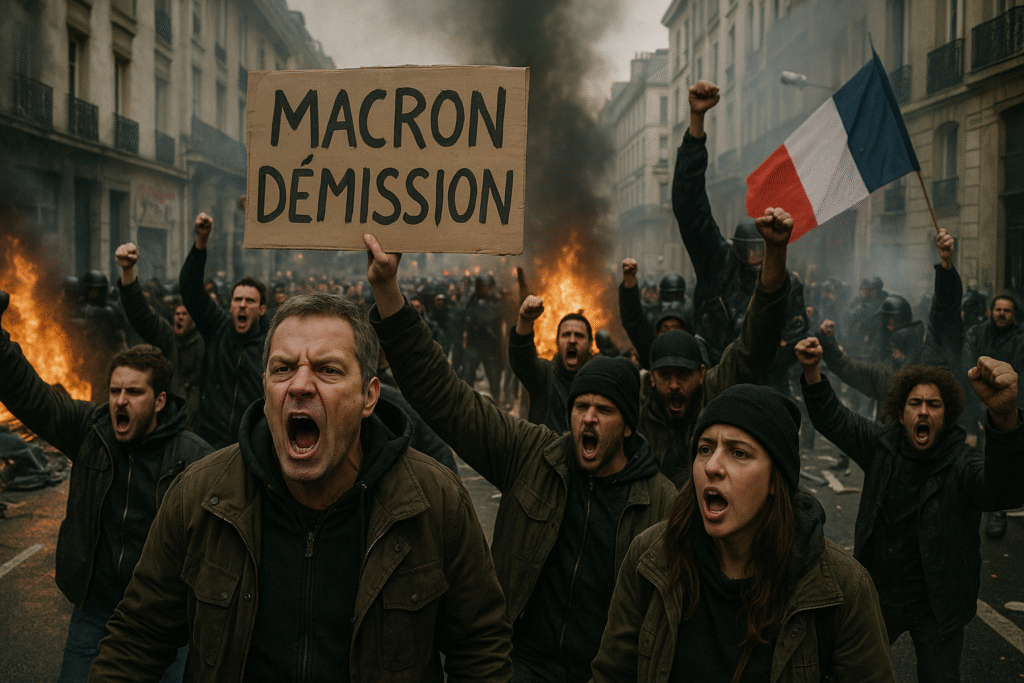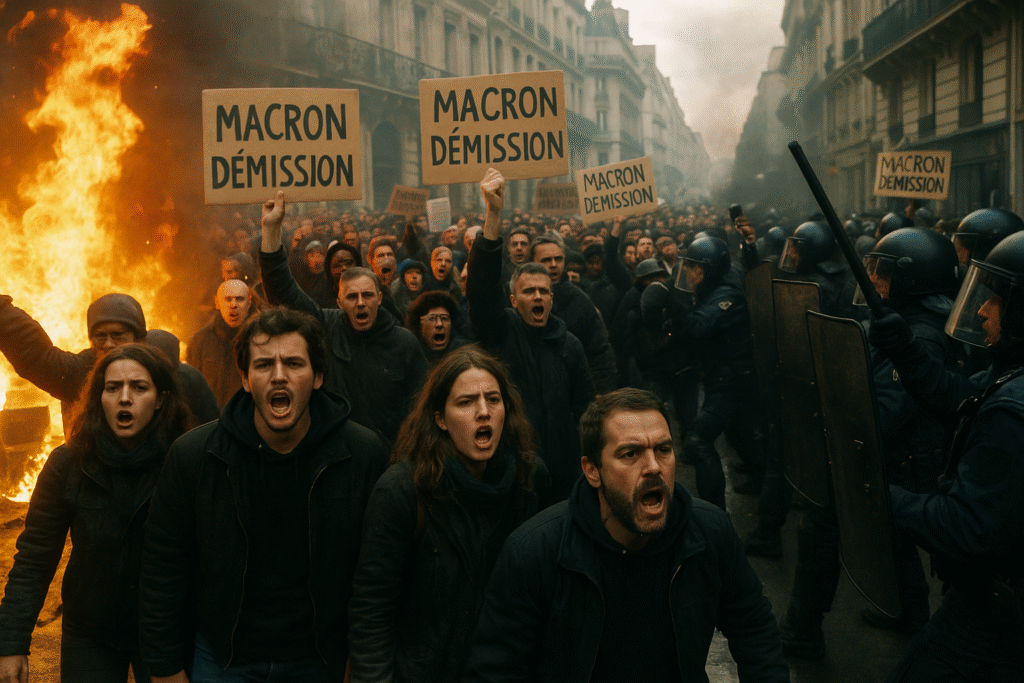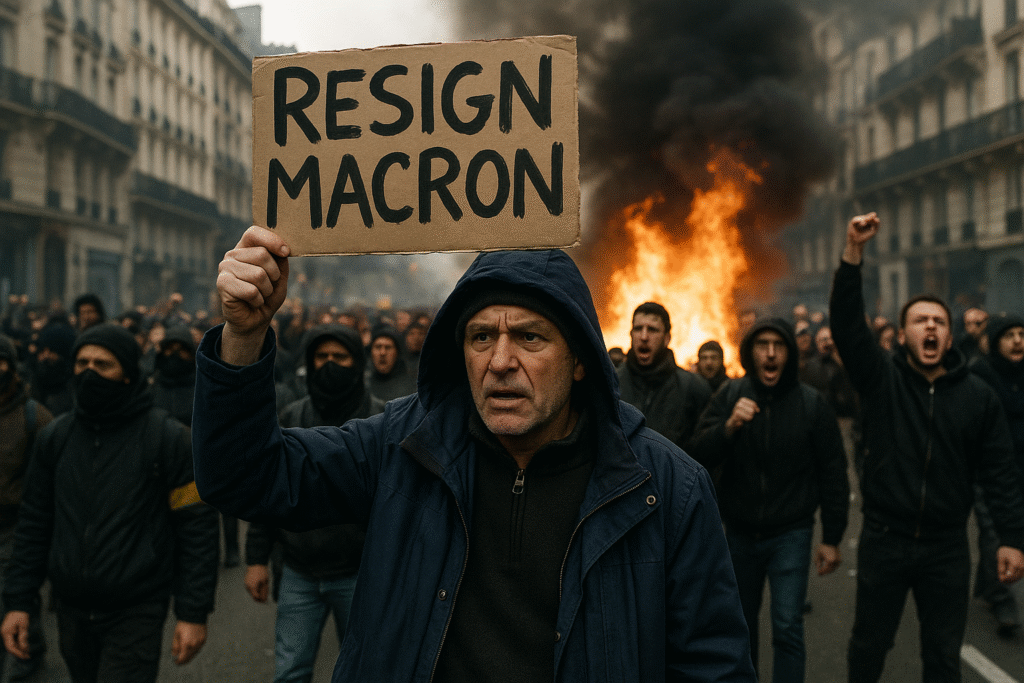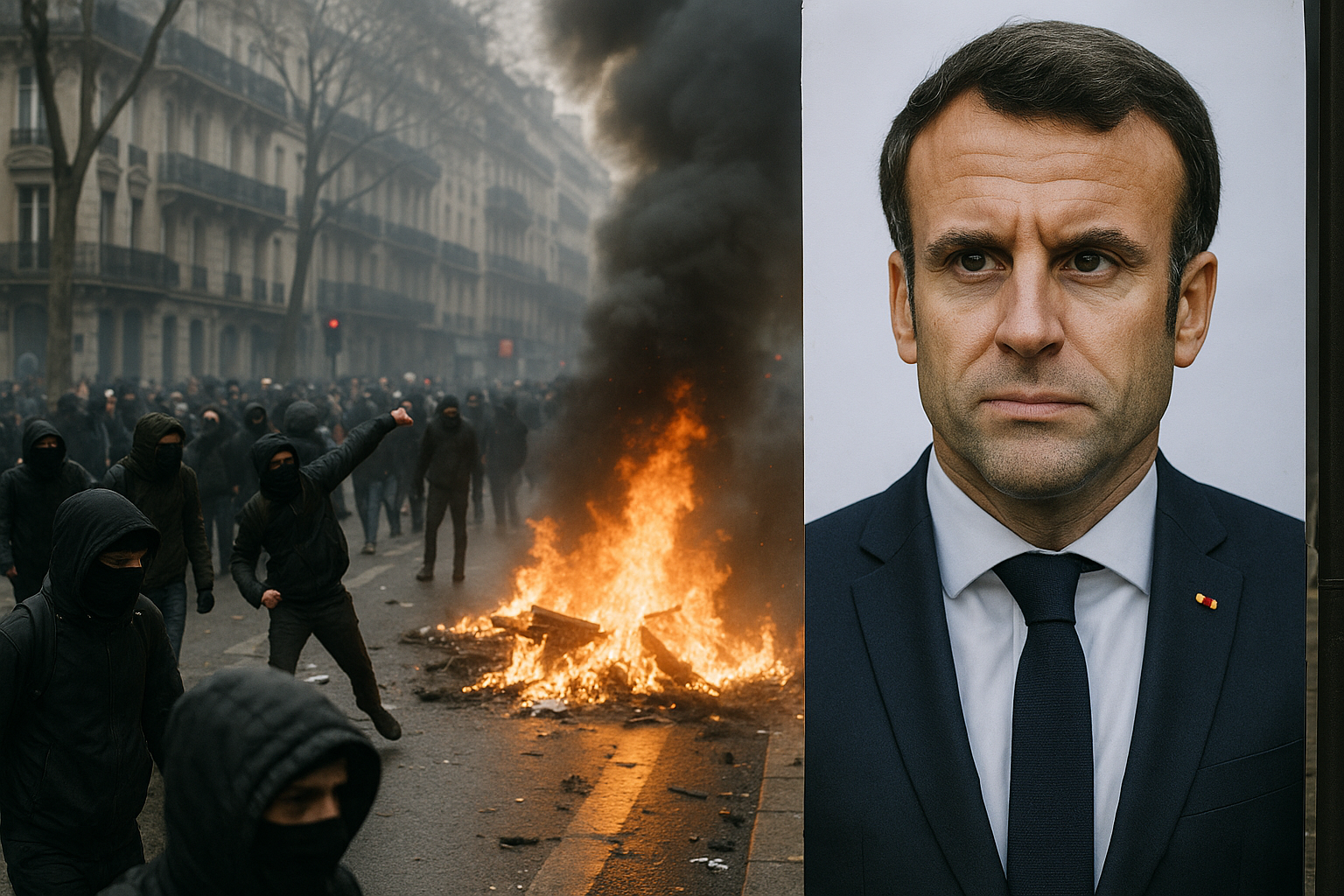Resign Macron protests 2025 — The short read
A wave of nationwide demonstrations and strikes that began in September expanded on October 2, 2025, as unions and a grassroots movement called “Bloquons Tout” (Block Everything) called fresh actions against proposed austerity measures and the government’s budget plans. Large rallies and blockades in more than 200–240 towns and cities included disruptive tactics, clashes with police, property damage in some locations and arrests. Slogans demanding “Macron démission” / “Resign Macron” have multiplied in the street protests, turning economic grievances into a direct political challenge to President Emmanuel Macron and his new government.
1) What exactly happened on October 2, 2025?
Trade unions (including CGT and CFDT) and the “Bloquons Tout” movement staged nationwide strikes and demonstrations in protest at planned spending cuts, rollback of some social protections, and the political stalemate following recent cabinet turmoil. Demonstrations were logged in over 200 towns and cities; Paris, Lyon, Nantes and other urban centres saw the largest turnouts. Police used heavy security deployments in many cities; authorities reported multiple arrests and instances of clashes and property damage where hard-line groups or “black bloc” elements engaged in confrontations. The Eiffel Tower temporarily closed during the Paris demonstrations.
2) Why are people chanting “Resign Macron”?
The chant “Macron démission” (or in English, “Resign Macron”) has reappeared because the unrest has moved beyond a narrow debate about a single policy. A string of events — large proposed budget cuts, unpopular pension changes in previous years, the collapse of the Bayrou government in September and the political uncertainty around Prime Minister Sébastien Lecornu’s incoming administration — has produced broad anger and a perception that the political elite is out of touch. Many protesters see President Macron as ultimately responsible for policy direction and accountability, so the slogan is both a vent of frustration and a political demand.

3) Who’s organizing the protests — unions, grassroots groups, or both?
This wave is hybrid. Established trade unions (CGT, CFDT and others) organised general strike days, co-ordinated workplace actions and march routes. Simultaneously, Bloquons Tout — a decentralised grassroots movement that grew on social media — has mobilised direct-action tactics (road blockades, “shutdowns” of transport nodes) and calls for general disruption. That combination makes the movement harder for authorities to negotiate with, and it increases the risk of localised violence when militant elements collide with police lines.
4) How violent are the protests — and where?
Most demonstrations remained peaceful, but some urban flashpoints saw clashes, arson of street furniture, lootings and property damage — patterns similar to earlier waves of unrest in France (e.g., 2018 Yellow Vests and 2023 pension protests). Police deployed water-cannon, tear gas and armoured vehicles in larger cities to prevent escalation; large numbers of arrests were reported during peak days. The presence of small groups who aim to provoke riotous encounters — often described in reporting as “black bloc” agitators — raises the violence risk in otherwise peaceful marches.
5) The political backdrop — what blew up inside Paris politics
France has had a turbulent 2024–25 political cycle: shifting governments, fierce parliamentary divisions and contested budget proposals. The Bayrou government lost a confidence vote in September and resigned; President Macron appointed Sébastien Lecornu as the new prime minister, but Lecornu has had to assemble a cabinet and craft a budget while facing strong street opposition. The budget deficit and pressure from EU fiscal rules are forcing difficult decisions, and attempts to deliver austerity or spending cuts have inflamed unions, students and left-wing parties — turning policy fights into direct public protests.

6) What are protesters demanding — beyond “Resign Macron”?
While the headline chant is simple, demands are varied:
- Unions: rollback of proposed budget cuts; protection of public services; fairer taxation (including calls for higher taxes on the wealthy).
- Grassroots: systemic change, including resistance to austerity and broader political reforms; some factions demand a general re-orientation of France’s social contract.
- Radical groups: a minority pushing for confrontational tactics or radical political outcomes — not representative of the majority of demonstrators.
7) Who’s being impacted — citizens, commuters, services?
- Public transport and schools: strike action and blockades have delayed or cancelled regional services, disrupted urban transit and forced some schools to close on major action days.
- Businesses: local shops in protest hotspots face temporary closures because of safety concerns or damage.
- Everyday commuters: diverted routes and longer commutes are typical during large demonstration days.
- Tourism & landmarks: iconic sites (e.g., Eiffel Tower) have closed temporarily during intense demonstrations.
8) Government response — policing, politics and negotiation
Authorities are balancing a three-pronged strategy:
- Strong security postures in cities with visible police deployments to prevent disorder.
- Political signalling — the presidency and prime minister’s office are under pressure to show both firmness and a willingness to open talks; Ministers have publicly rejected large-scale U-turns on budget targets while offering minor concessions in specific areas.
- Engagement with union leaders — talks may be restarted, but the presence of autonomous grassroots actors complicates formal negotiations.

9) Economy & markets — is France at risk of deeper damage?
Large, sustained strikes and transport blockades increase short-term costs: lost GDP for strike days, logistical bottlenecks and investor unease. Over the medium term, political instability can make it harder to pass fiscally necessary but unpopular reforms — which raises the risk of higher borrowing costs if markets fear policy paralysis. EU institutions will be watching France’s fiscal plan and any slippage on deficit targets, which adds an external pressure point on domestic politics.
10) International reaction — what foreign leaders and organisations are saying
International media have covered the unrest extensively; European partners watch with concern because France is the eurozone’s second-largest economy and a key EU actor. Official reactions so far have tended to call for calm, stress the need for peaceful protest and emphasise the importance of democratic processes. Multilateral organisations will monitor fiscal developments closely given spillover risks. (For live diplomatic statements, follow foreign ministries and the EU’s official channels.)
11) How to follow the story responsibly (trusted channels)
If you want to stay informed without amplifying rumours:
- Use reputable wire services and major outlets for facts (Reuters, AP, BBC, France24, The Guardian).
- Follow official accounts (French Interior Ministry, prefectures, CGT/CFDT for union notices) for practical updates about routes and safety.
- Avoid sharing unverified videos or eye-witness footage before it’s corroborated — such content is often misleading and can inflame tensions.
12) What could happen next — scenarios to watch
- De-escalation through talks: unions win concessions on key measures, reducing street pressure — the most stable path.
- Continued stalemate and escalation: repeated strike days and Block Everything actions widen disruptions, raising the chance of more clashes.
- Political fallout: sustained public pressure could intensify calls for political change, but France’s constitution offers no simple path to force a presidential resignation; changes are more likely through elections or parliamentary manoeuvres over time.
A responsible checklist for readers (if you’re in France or following from abroad)
- ✅ Rely on official updates for safety/transport information.
- ✅ Attend only peaceful, authorised events and respect leaders’ guidance.
- ✅ If giving to charities or victims’ funds, donate only via verified organisations.
- ✅ Avoid sharing graphic or unverified content.
- ✅ Report witnessed hate crime or violence to local police and official hotlines.
Why this coverage matters — TrenBuzz’s editorial approach
We aim to explain immediate facts, broader causes and practical consequences without sensationalism. That means:
- Focusing on verified facts from wire services and official statements.
- Avoiding graphic imagery and speculation.
- Helping readers separate legitimate protest from criminal vandalism and violent fringe action.
Verified external sources
France 24 — French unions call new strike and protest day for October 2 (Sept 24, 2025). https://www.france24.com/en/france/20250924-french-unions-call-new-strike-and-protest-day-for-october-2 (France 24)
Disclaimer: This article is intended to inform readers using reputable news agencies, union statements and government releases current as of October 2, 2025. Details of protests, arrests and government responses can change as investigations and official briefings continue. Always consult direct official sources (Interior Ministry, local prefectures, union notices) for immediate safety and travel advisories. Images used in this article are royalty‑free or licensed for commercial use and are provided here for illustrative purposes.
